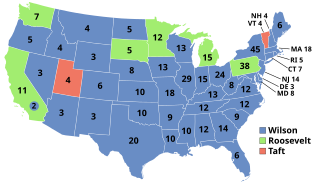
Locke Craig, an American lawyer and Democratic politician, was the 53rd governor of the U.S. state of North Carolina, serving from 1913 until 1917.

Thomas Settle was an American lawyer who served for two terms as a member of the U.S. House of Representatives from North Carolina from 1893 to 1897. A Republican, he was the son of Thomas Settle, a judge and politician in North Carolina, and a grandson of Thomas Settle (1789–1857), also a U.S. Representative from North Carolina.

The 1912 United States presidential election in Pennsylvania took place on November 5, 1912 as part of the 1912 United States presidential election. This was the first time that Arizona and New Mexico took part in a presidential election having been admitted to the Union earlier in the year. Voters chose 38 representatives, or electors to the Electoral College, who voted for president and vice president.

The 1912 United States elections elected the members of the 63rd United States Congress, occurring during the Fourth Party System. Amidst a division between incumbent Republican president William Howard Taft and former Republican president Theodore Roosevelt, the Democratic Party won the presidency and both chambers of Congress, the first time they accomplished that feat since the 1892 elections.

The 1914 Wisconsin gubernatorial election was held on November 3, 1914. Primary elections were held on September 1, 1914.

The 1914 Oklahoma gubernatorial election was held on November 3, 1914, and was a race for Governor of Oklahoma. Democrat Robert L. Williams narrowly defeated Republican John Fields and Socialist Fred W. Holt. Also on the ballot were Independents Amos L. Wilson and T. J. Wood as well as Progressive Party nominee John P. Hickam. The Prohibition Party also had ballot access but did not run a candidate in the general election.

The 1913 Massachusetts gubernatorial election took place on November 4, 1913. Democratic Lieutenant Governor David I. Walsh defeated the Progressive, Republican and independent candidates Charles S. Bird, Representative Augustus Peabody Gardner and incumbent Governor Eugene Foss with 39.77% of the vote. Suffolk County was the only county to give more than 50% of its vote to a candidate and had given Walsh 53.98% of its vote.

The 1912 Massachusetts gubernatorial election took place on November 5, 1912. Democratic Governor Eugene Foss defeated the Republican candidate Joseph H. Walker and Progressive candidate Charles S. Bird.

The 1912 Michigan gubernatorial election was held on November 5, 1912. Democratic nominee Woodbridge N. Ferris defeated Republican candidate Amos S. Musselman with 35.35% of the vote.

The 1912 Florida gubernatorial election was held on November 5, 1912. Incumbent Governor Albert W. Gilchrist was term-limited. Democratic nominee Park Trammell was elected with 80.42% of the vote.

The 1952 Indiana gubernatorial election was held on November 4, 1952. Republican nominee George N. Craig defeated Democratic nominee John A. Watkins with 55.68% of the vote. Craig and Handley became the first gubernatorial ticket in Indiana history to receive more than one million votes.

The 1912 North Dakota gubernatorial election was held on November 5, 1912. Republican nominee L. B. Hanna defeated Democratic nominee Frank O. Hellstrom with 45.45% of the vote.

The 1908 North Carolina gubernatorial election was held on November 3, 1908. Democratic nominee William Walton Kitchin defeated Republican nominee J. Elwood Cox with 57.31% of the vote. At the time, Kitchin was a congressman, while Cox was a banker and manufacturer.

The 1912 Ohio gubernatorial election was held on November 5, 1912. Democratic nominee James M. Cox defeated Republican nominee Robert B. Brown with 42.38% of the vote.

The 1912 New Hampshire gubernatorial election was held on November 5, 1912. Democratic nominee Samuel D. Felker defeated Republican nominee Franklin Worcester with 41.07% of the vote.

The 1912 Iowa gubernatorial election was held on November 5, 1912. Republican nominee George W. Clarke defeated Democratic nominee Edward G. Dunn with 39.93% of the vote.

The 1912 Indiana gubernatorial election was held on November 5, 1912. Democratic nominee Samuel M. Ralston defeated Progressive nominee Albert J. Beveridge and Republican nominee Winfield T. Durbin with 42.95% of the vote. The vote splitting between the Republican and Progressive nominees benefited Democrat Ralston tremendously in this election.

The 1912 Delaware gubernatorial election was held on November 5, 1912. Though Republican Governor Simeon S. Pennewill was eligible for re-election, State Senator Charles R. Miller was nominated by the state Republican convention. With the nationwide rise of the Progressive Party, Delaware Republicans were keen to not lose the race due to a strong showing by a Progressive candidate; Miller was seen as amenable to all factions of the Republican Party and to Progressives. In the general election, Miller faced Democratic nominee Thomas M. Monaghan, who had been elected as State Senate President in a majority-Republican chamber as the result of a coalition agreement with Progressives, and Progressive nominee George B. Hynson.

The 1912 Montana gubernatorial election was held on November 5, 1912.

Iredell Meares was an American lawyer, public speaker, and politician in North Carolina. His obituary describes him as one of lower Cape Fear's most colorful characters.
























